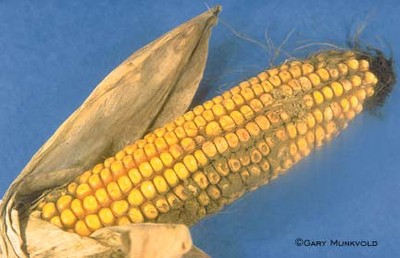
Source: Gary Munkvold, Iowa State University Plant Pathology
Symptoms:
Aspergilllus is a gray-green, powdery mold that starts at the tip of the ear or follows insect tracks. Primarily it is considered to be a storage mold. Aspergillus ear and kernel rot is associated with mycotoxins.
Cause:
There are several species of Aspergilllus fungi. Occurrence is much more common in hot, dry years. This fungus can produce mycotoxins (aflatoxin) . It can grow at temperatures higher than 90° F, and grain moisture content as low as 15 percent. The fungus can be detected in corn because it produces compounds that are fluorescent under black light, but this does not directly detect the presence of aflatoxins.
Management:
Plant a hybrid with ear rot resistance; avoid planting corn on corn, especially under conservation tillage, and reduce stress on the plants with adequate fertilization and good insect pest management.
References:
Lipps, P. E., A. E. Dorrance, and Dennis Mills. 2004. Corn Disease Management in Ohio Bulletin 802.
White, Donald G. (ed.). 1999. Compendium of Corn Diseases (3rd Edition). APS Press, The American Phytopathological Society.
